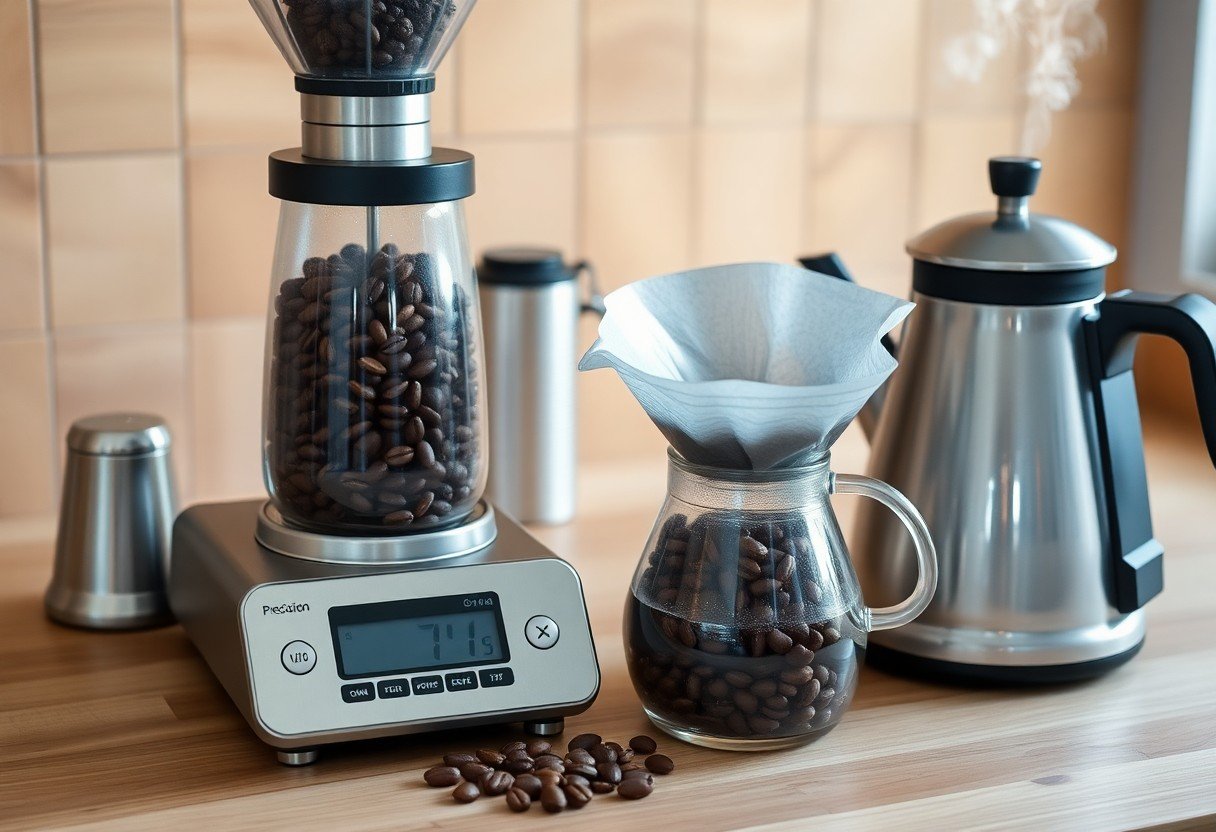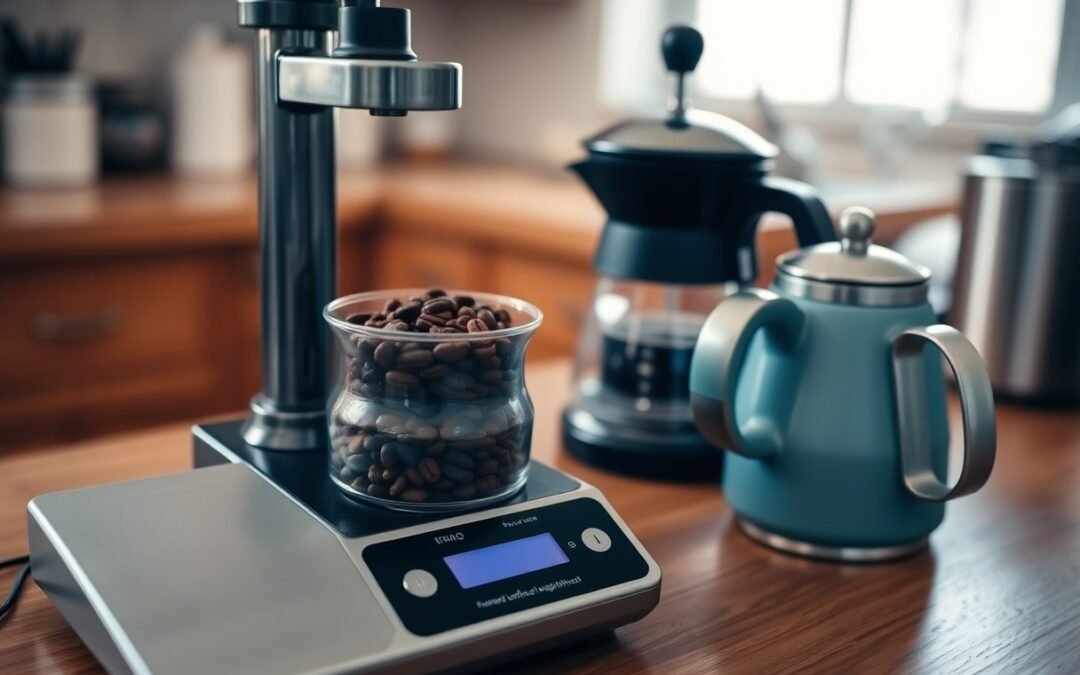Tips for achieving optimal freshness with your coffee beans are important for enhancing your brewing experience. By understanding how to store, grind, and brew your beans, you can preserve their rich flavors and aromas. This guide will provide you with expert insights to keep your coffee tasting as fresh as possible, ensuring every cup you brew is a delightful treat. Let’s explore the methods that will elevate your coffee game and keep those beans at their best!
The Impact of Freshness on Flavor
Freshness significantly influences the flavor profile of your coffee. As beans age, they lose vital oils and compounds that contribute to their rich and nuanced taste. Over time, coffee becomes flat and dull, often developing undesirable flavors. You’ll notice that recently roasted beans yield a more vibrant cup with pronounced acidity and depth, while older beans result in a muted experience that lacks complexity. This transformation is a vital aspect of why you should prioritize freshness in your brewing routine.
Chemical Changes Over Time
As coffee beans age, they undergo several chemical changes that detrimentally affect flavor. Oxidation is a primary factor, breaking down the volatile compounds that impart aroma and taste. Additionally, moisture exposure can foster unwanted microbial growth, further deteriorating the beans. Research indicates that significant flavor degradation occurs within two weeks post-roasting, underscoring why freshly roasted beans should be your go-to choice for brewing.
Sensory Experiences of Fresh Coffee
The sensory experiences of fresh coffee are unparalleled, showcasing a rich array of aromas and flavors that transport you to different origins. A freshly brewed cup can entice your senses with bright notes of citrus, sweet undertones of chocolate, or earthy hints of nuts, depending on the bean origin. The tactile feel of freshly ground coffee beans also matters, as their oily surface enhances the brewing process, extracting maximum flavors and aromas. Enjoying coffee at its freshest allows you to truly appreciate the artistry behind each cup.
This extraordinary sensory richness stems from volatile compounds released during the brewing process, which are at their peak immediately after roasting. The aromatic qualities can profoundly enhance your overall tasting experience, with fresh coffee delivering a symphony of textures, scents, and flavors. Carefully selecting freshly roasted beans can open up a world where each sip unravels new surprises, inviting comparisons to various flavor notes found across different batches and origins. By prioritizing freshness, you elevate your morning ritual into a delightful exploration of coffee’s intricate profile.
Essential Variables for Preserving Freshness
Several factors critically influence your coffee beans’ freshness, such as storage conditions, packaging techniques, and environment control. Mastering these aspects allows you to enjoy the vibrant flavors and potent aromas in every cup. Understanding how these variables interact will lead you to make informed choices to enhance your coffee experience.
Storage Conditions: Light, Air, and Temperature
Optimal storage conditions are imperative for maintaining your coffee’s natural flavors. Here’s a quick overview:
| Condition | Recommendation |
|---|---|
| Light | Store in a dark place to avoid degradation. |
| Air | Use airtight containers to minimize oxidation. |
| Temperature | Keep at a stable, cool temperature, ideally below 75°F (24°C). |
Packaging Techniques that Lock in Flavor
Your choice of packaging plays a vital role in preserving the freshness of your coffee beans. Opt for bags made of foil or other materials with barrier properties to shield from air, light, and moisture. Properly sealed packaging with one-way valves can help release carbon dioxide while preventing oxygen from entering, maintaining your beans’ integrity. Look for options labeled ‘vacuum-sealed’ or ‘nitrogen-flushed’ for maximum freshness and longevity.
Specialty coffee retailers often utilize advanced packaging techniques, like ethylene-absorbing materials, to combat freshness issues. These methods can extend shelf life significantly, often up to several months, without the need for refrigeration or freezing. Investing in high-quality packaging can mean the difference between a lackluster cup of coffee and a rich, aromatic experience that fully showcases your chosen beans’ unique characteristics. Ensure you also pay attention to how you open and reseal bags to maintain integrity after the first use.
Choosing Quality Beans: Bean Origin Matters
Your coffee experience begins with the beans you choose, and their origin plays a significant role in flavor and quality. Regions known for exceptional coffee, such as Ethiopia, Colombia, and Kenya, provide unique flavor profiles shaped by their climate, altitude, and soil. As you explore different origins, you’ll discover notes ranging from fruity or floral in Ethiopian beans to the nutty or chocolatey flavors from Colombian varieties. Understanding these unique characteristics allows you to select beans that match your palate preferences, ensuring a more satisfying cup every time.
Specialty Coffee vs. Commercial Brands
Specialty coffee typically represents the highest quality beans, sourced from specific regions and processed with meticulous care. Often, these beans have unique tasting notes and can be traced back to a single farm or cooperative. In contrast, commercial brands generally source their beans in bulk, prioritizing cost-efficiency over flavor complexity. While commercial options may be more accessible, choosing specialty coffee can elevate your brewing experience and introduce you to a world of diverse flavors.
Understanding Roast Dates and Their Relevance
Roast dates greatly impact the flavor of your coffee. Freshly roasted beans provide the most vibrant and nuanced flavor, while older beans can lose their essence over time. Ideally, you should consume coffee within two to four weeks of roasting for optimal freshness. Look for bags that clearly indicate the roast date and seek out local roasters who prioritize freshness, ensuring that your next brew delivers the bold flavors and delightful aromas you crave.
Many coffee enthusiasts fail to realize how quickly flavor diminishes after roasting. Once roasted, beans undergo a process called degassing, where carbon dioxide escapes and flavor compounds begin to dissipate. A bag of coffee that’s past its peak freshness may taste flat, stale, or even rancid. By understanding roast dates, you not only preserve the beans’ integrity but also help you fine-tune your brewing methods to align with the coffee’s intended flavor profile, ultimately enhancing your overall coffee enjoyment.

Brew Techniques for Maximum Freshness
Your brewing technique significantly affects the freshness and flavor of your coffee. Choosing the right approach can elevate the rich notes of freshly roasted beans while minimizing oxidation and flavor loss. Experimenting with different methods such as pour-over, French press, or AeroPress can help you find the perfect way to extract optimal freshness from your beans. Each method requires attention to detail, including water temperature and brew time, which can all enhance your coffee’s profile.
Grind Size and Its Influence on Flavor
The grind size of your coffee beans directly influences the extraction process and, consequently, the flavor profile of your brew. A finer grind increases the surface area exposed to water, resulting in a faster extraction, which may yield a bolder taste but risks over-extraction and bitterness. Conversely, coarser grinds allow for a slower extraction, emphasizing smoother flavors. By adjusting your grind size to match your brewing method, you can optimize the coffee’s taste and aroma.
Optimal Brewing Methods for Fresh Coffee
Several brewing methods can enhance the freshness of your coffee, with each having its distinct advantages. Pour-over techniques provide greater control over water flow and extraction time, ensuring maximum flavor is preserved. French press, with its immersion brewing style, allows the coffee grounds to steep longer, resulting in a rich and full-bodied cup. For convenience and consistency, using an AeroPress can produce a clean and vibrant brew in just a few minutes. Evaluating your preferences for taste and convenience will help you select the best method that complements the freshness of your beans.
Creating Your Coffee Freshness Plan
To maintain the peak freshness of your coffee, develop a tailored freshness plan. This involves establishing a consistent approach to sourcing, storing, and consuming your coffee beans. By doing so, you can ensure that your brews deliver the vibrant flavors and enticing aromas that make each cup an enjoyable experience. Your plan should encompass purchasing schedules, storage methods, and consumption timelines, all designed to minimize exposure to air, moisture, and light.
Establishing a Purchasing Schedule
A purchasing schedule tailored to your consumption habits will help you maintain an optimal supply of fresh coffee. Assess your weekly or monthly coffee intake and adjust your buying frequency accordingly. For instance, if you consume an average of one pound of coffee per week, aim to purchase smaller batches that will last only a couple of weeks to guarantee freshness while avoiding waste.
Strategic Use of Freezing for Longevity
Freezing your coffee beans can be an effective method to prolong their freshness, especially for those who buy in bulk. Store unground beans in an airtight, moisture-proof container before placing them in the freezer. This adds a multi-layered barrier against oxidation and flavor loss, ensuring that the beans retain their quality until you’re ready to use them.
When considering freezing, treat it as a valuable strategy rather than a default storage method. For optimal flavor retention, only freeze coffee beans once, as repeated thawing can expose them to moisture and degrade their taste. Ideally, portion out the amount you typically use within a week into separate containers, allowing you to take out only what you need. Thaw these portions in the refrigerator for a few hours before using, which helps maintain the flavor profile. By embracing this approach, you can amp up your coffee experience while reducing waste.
Summing up
Presently, achieving optimal freshness with your coffee beans involves implementing simple yet effective practices. You should store your beans in an airtight container, keep them in a cool, dark place, and grind them just before brewing. By paying attention to the quality of your water and considering your brewing method, you can enhance the overall taste and aroma of your coffee experience. Following these expert tips will ensure that each cup is as fresh and flavorful as possible, allowing you to fully enjoy your daily brew.
Q: How can I store my coffee beans to maintain their freshness?
A: Storing coffee beans properly is imperative for maintaining their freshness. It is best to keep them in an airtight container that is opaque and dark to protect them from light, air, and moisture. A sealed bag with a one-way valve or a vacuum-sealed container can also help keep beans fresh. Avoid storing beans in the fridge or freezer, as temperature fluctuations can affect their quality.
Q: What is the ideal environment for keeping coffee beans?
A: Coffee beans thrive in a cool, dark, and dry environment. The average temperature should be between 60°F to 70°F. Keep them away from direct sunlight, heat sources, and humidity, as these factors can accelerate the aging process and lead to a loss of flavor. The pantry or a kitchen cabinet that stays away from heat is often an ideal location.
Q: How often should I buy coffee beans for optimal freshness?
A: To achieve the best flavor and aroma, it’s recommended to buy coffee beans in small quantities, ideally every 2 to 4 weeks, depending on your consumption rate. This ensures that you are using fresh beans rather than older ones that have begun to lose their flavor over time. Always check the roast date and choose beans that have been roasted recently for the best results.

